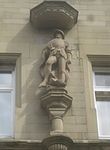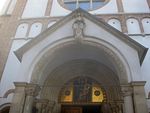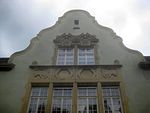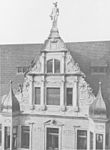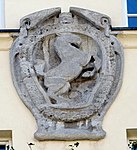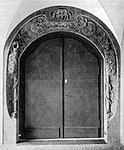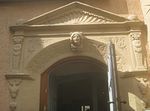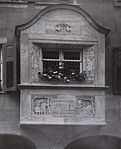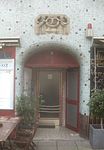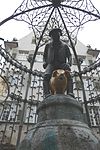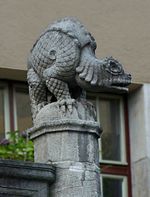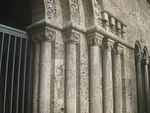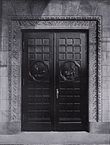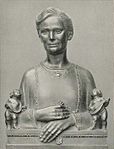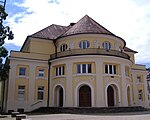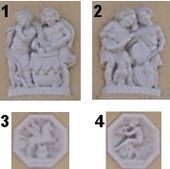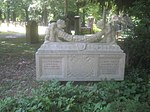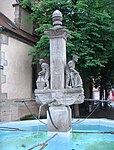Josef Zeitler
Josef Zeitler , also Joseph (born September 24, 1871 in Fürth ; † March 24, 1958 in Stuttgart ) was a German sculptor who stood out primarily through plastic architectural jewelry in Stuttgart and all of Württemberg . He settled in Stuttgart in 1897 and taught there from 1923 to 1937 as a professor at the higher building school . In 1941 Zeitler planned a "autobiography, which he wanted to publish on his 70th birthday as a review and account of an active and eventful life as an artist". It is not known whether Zeitler actually wrote this autobiography , nor is anything known about the whereabouts of his estate .
Life
Zeitler was born in the Franconian town of Fürth in the Heiligen Gasse (today Heiligenstraße), later the family lived mainly in the Schützenstraße (today Wilhelm-Löhe-Straße). Zeitler told of his birth in his humorous way: "My father claimed that I would have gone into a beer mug, I was so small and nobody would have promised me a long life." Josef's father was the master carpenter AP Zeitler, who met his son at an early age "Too strict professional cooperation" persisted. The father's main business was the manufacture of elaborate jewelry boxes.
Zeitler attended elementary school until he was 13 . His mother (1840–1880), his father's first wife, was “a pious and art-loving woman” who would have liked to turn her son into a painter. His favorite subjects were drawing, singing, gymnastics and geography. A relative of his mother, Vetter Kriegbaum, a painter and photographer, gave him drawing lessons from the age of six. Zeitler later said of him: "This man with his noble nature had the greatest influence on my entire childhood." At the age of nine, the little Zeitler opened a drawing school for children, in which "mostly ... Jumpos (elephants) were drawn". In the meager free time that was left to play, he loved to play circus, puppet theater and theater games. His father's second wife was the younger daughter of Theodor von Muncker , who was Mayor of Bayreuth from 1863 until his death in 1900 and played a key role in the realization of Richard Wagner's festival idea in Bayreuth. Zeitler often came to Bayreuth through his stepmother. "The father of this second woman was close friends with Richard Wagner and so I came to the " Wahnfried "house almost every day and became Siegfried's good friend and playmate."
Apprenticeship
After finishing school, around 1884 at the age of thirteen, Zeitler was sent to an apprenticeship in Gütersloh in Westphalia to his uncle Johann Zeitler, who ran a prosperous workshop for Christian art. “After four years of hard but also very fruitful apprenticeship ... he moved from there by night and fog; the young journeyman , conscious of his ability as a stonecutter , sculptor, carpenter and wood turner is just not like longer than a nanny, house servant and Viehfütterer can use. "If Hafner champion in Aschaffenburg learned it" in a few weeks, the art of ceramics ".
Munich
Then he came back to Fürth for a few weeks around 1888, in order to “escape” to Munich after an inevitable interlude as a carver of mirror frames . Here the seventeen-year-old Zeitler continued his training with the sculptor Josef Flossmann and also came into contact with the renowned architects Gabriel von Seidl , Emanuel von Seidl , Theodor Fischer , Friedrich von Thiersch , Georg von Hauberrisser and Hans Grässel , through whom he, among others Found work on the decoration of the Bavarian National Museum , the New Town Hall , the Palace of Justice and the Church of St. Anna im Lehel .
In the Bavarian capital, Zeitler also worked in a studio for Christian art. There he met Ignatius Taschner , who was of the same age and who studied at the Munich Art Academy from 1889 to 1895 . Taschner was a fun-loving Franconian like Zeitler, and both were in many ways related. Both worked in a wide variety of materials, both loved the small sculptures and the popular genre and fairy tale motifs. They received the order from Sebastian Kneipp to create an altar for Bad Wörishofen , the first major order for both of them. While Zeitler later remained stuck with tradition in his art style, the versatile Taschner developed into Art Nouveau without giving up his inclination for folk art.
Wandering years
It is not known when Zeitler left Munich, at least he then began his years of wandering , which took him “without any cash as a traveling journeyman” on foot across Germany and to Italy, France, the Netherlands, Belgium, Switzerland, Austria, Hungary, Dalmatia , Great Britain, Denmark and Sweden led. On the way he hired himself as a sculptor in order to earn a living and to perfect himself in his profession. In connection with the work on the interior of the Berlin City Palace , he spent a year studying in Paris to copy a room in Fontainebleau Palace on behalf of Kaiser Wilhelm II . In Paris he attended the Académie Julian and met the famous sculptor Auguste Rodin , who congratulated him “on his two first works: figural wood carvings with an intimate, humorous touch”. In Brussels he worked on the artistic decoration of Joseph Poelaert's Palace of Justice and in Liège on the design of the town hall stairs.
Zeitler also worked on the decoration of many buildings in many cities in Germany, including in Berlin , where he worked on the Reichstag building and the State Library as well as on the interior of the Berlin City Palace under the architects Paul Wallot , Alfred Messel and Ludwig Hoffmann . His work in Berlin earned him an invitation to dinner, where he sat next to Bismarck , who remarked appreciatively: “Well, you little man have already achieved great things”. He was also employed at the Hamburg City Hall , at the synagogues in Mainz and Frankfurt am Main, on buildings in the cities of Cologne and Münster, and on a church in Düsseldorf built by Heinrich Jassoy . Jassoy, who built Stuttgart's town hall, recommended him to go there, where he and 140 other sculptors were entrusted with work for the new town hall. Among other things, he created 14 reliefs that are now kept in the depot of the city archives after the town hall was largely destroyed in the Second World War and are hidden from the public.
On his travels he probably met his first wife, who gave birth to two daughters, the older one was born in Cologne in 1893 and the younger one in Düsseldorf in 1895. In the same year Zeitler stayed temporarily in Stuttgart, where he created the plastic jewelry for the house at Mörikestrasse 21.
In 1932 Zeitler drew the sum of his years of travel: after he had gone to Munich, “began a life full of privations, disappointments but also full of rich successes. From the age of 14 I didn't cost my father a penny anymore, because I did not attend an art academy or art school, but instead worked for our most famous masters in their studios at home and abroad and helped create important buildings, including all European countries traveled and seen and learned a lot. "
Stuttgart
In 1897 Zeitler and his family settled in Stuttgart, where he lived for the first three years in Alexanderstraße 170. Until his evacuation in World War II, he lived with his family in various rented apartments in the city center (Heusteigstrasse 103, Seestrasse 97, 102, 32, Jägerstrasse 34, Alleenstrasse 36).
In 1903 he rented a studio in the house at Rote Strasse 7 (today Theodor-Heuss-Strasse), later in the house at Marienstraße 9, and from 1911 to 1927 three floors in the house at Marienstraße 48a, where his auxiliary sculptors, whom he hired to handle his many commissions, also stayed . From 1928 until his retirement he had a studio at the higher building school and from 1941 to 1943 and after the war in the house at Weißenburgstrasse 35. In the first few years Zeitler was entered in the address book as a modeller, later as a sculptor, then as a master sculptor.
In Stuttgart Zeitler was “overwhelmed with orders”. From 1901 until well into the 1920s, he was often entrusted with the sculptural furnishing of churches and public buildings in Stuttgart, but also elsewhere in Württemberg (Elisabethenkirche, St. Fidelis Church, Heilandskirche, Schlachthof, Hans-Sachs-Haus, Heusteigschule) , Graf-Eberhard-Bau, Salamanderbau, market hall, town hall, art building, Hans-im-Glück-Brunnen, forest cemetery, main cemetery). During the redevelopment of the old town in Stuttgart from 1906–1909, he supplied the plastic jewelry for all newly built buildings. He worked with all well-known architects, including Theodor Fischer , Karl Hengerer , Paul Bonatz , Paul Schmohl , Albert Eitel , Martin Elsaesser , Albert Pantle and Clemens Hummel .
Teaching
Even before the First World War, Zeitler had received calls from the arts and crafts schools in Cologne and Berlin, which he turned down at the insistence of influential personalities. On July 1, 1923 or as early as 1922, Zeitler was appointed professor at the State Higher Building School in Stuttgart, which resided in the historic Egle Building (Schellingstrasse 24), Building 1 of today's University of Technology . He taught freehand drawing and modeling as well as perspective drawing at the school for 15 years . In accordance with the school's mandate to offer practical training in the building trades, Zeitler's practice-oriented lessons turned the "offspring of young architectural sculptors into the best artisans". From 1928 Zeitler also had his studio in the building school. In the spring of 1937 Zeitler was released from his duties because he had reached the age limit .
Second World War
Zeitler was 68 years old when World War II broke out. During the war, in 1943 at the latest, Zeitler and his wife moved to Kiefersfelden in Upper Bavaria , where he stayed with the Stuttgart sculptor Emil Hipp . In 1933, Hipp won a competition from the city of Leipzig for a monumental Richard Wagner monument to be erected in the Richard Wagner grove that was to be built. It can be assumed that Zeitler, who was friends with Siegfried Wagner in his childhood , worked on the construction of the monument, especially since Hipp's auxiliary workers had been drafted into the war. The monument was completed in 1944 but never erected.
From Kiefersfelden, Zeitler tried to bring the project of a fountain "Schöne Lau and Stuttgarter Hutzelmännlein " in Stuttgart under one roof. The written negotiations dragged on, and after the devastating air raids in 1944 the city council had other concerns.
Since Zeitler had settled in Stuttgart at the turn of the century, he was well supplied with orders for over three decades. Despite his good income, Zeitler did not acquire any real estate, but with great passion put together an expensive and valuable art collection ("one of the most important private art collections in Württemberg"), which was also intended as a pension. According to Zeitler, the value of the collection was 80,000 Reichsmarks , and for some individual items (by Tilman Riemenschneider , Veit Stoss , Syrlin) an American museum is said to have offered him one million Reichsmarks. In 1943 Zeitler gave his collection to the city of Stuttgart for safekeeping in the salt mines in Kochendorf . The larger, more valuable part, however, was stored in Castle Löwenstein , contrary to the agreement . This was "set on fire two days before the end of the war" and Zeitler's art collection was destroyed.
Age
After the end of the war, Zeitler and his wife returned to Stuttgart, where he lived until his death in Degerloch in Reginenstrasse 38 (at least from 1948). Unlike after the First World War, the 74-year-old Zeitler was only given a few jobs after the Second World War. His wife's house (Seestrasse 32) had been bombed out and he received a pension of around DM 500 for his 15 years at the higher building school , which was around one and a half times the average income at the time . Zeitler found the level of his income precarious, especially since he had to pay the rent for his studio in Weißenburgstrasse 35. The only known public contracts after the war were the Bienenbrunnen (1945) and the Burgbrünnele (1949), both in Stuttgart- Wangen . In addition, Zeitler received an order from the city in 1949 to design a commemorative plaque that brought him 155 DM net.
From 1949 to 1955 Zeitler tried in vain to offer the city his Schöne Lau fountain. Zeitler's art was considered to be out of date and also believed that it could not justify the high price demanded. The idea of granting him a modest "honorary salary" was rejected because his income was estimated to be too high. In correspondence with the city, Zeitler repeatedly pointed out the loss of his art collection, which in his opinion the city was responsible for. However, the city declined to compensate Zeitler for his war losses. As a result, Zeitler tried in 1954 to obtain compensation through legal action. This attempt was also unsuccessful.
family
Nothing is known about Zeitler's first wife. Judging by the years of birth of the daughters, the marriage took place in 1893 or earlier. In 1913 Zeitler made a bronze bust of her, which was destroyed in World War II. The first marriage resulted in two daughters. The older daughter Magdalene Giessenhoffer-Zeitler (* 1893) was born in Cologne and later lived with her husband, the lawyer Robert Giessenhoffer (* 1890), in Stuttgart. She mainly worked as an abstract painter, but also created a figurative fresco on the life of St. Fidelis von Sigmaringen for St. Fidelis Church in Stuttgart, for which Zeitler had created a group of figures and two friezes. (The fresco was destroyed in the Second World War in 1944. ) The younger daughter Anny (* 1895) was born in Düsseldorf and married the painter Oswald Poetzelberger , with whom she lived in Munich and after the Second World War on the island of Reichenau . Zeitler's son Paul H. Zeitler lived in Richmond, Virginia, USA. Nothing more is known about him.
After the death of his first wife, Zeitler married the widow Emmy Löble b. Lehrenkrauss (1886–1968), a daughter of the Stuttgart baker Adolf Lehrenkrauss. After the death of his parents around 1935, through her deceased husband, she inherited the house at Seestrasse 32, which was destroyed in the Second World War.
death
In the last years of his life, Zeitler suffered from a serious eye condition that almost led to blindness. His last works were the altar for the St. Fidelis Church in Stuttgart, for which he had created a group of figures above the main portal and two angel friezes in 1925, and the model of a figure by "Walter von der Vogelweide".
Josef Zeitler died on March 24, 1958 at the age of 86. His wife moved from Degerloch to the house at Stöckachstrasse 23 in Stuttgart-Ost and died a decade later in 1968 at the age of 82. Both are buried in a grave on the Stuttgart forest cemetery in department 10n.
plant
Zeitler is mainly perceived as a building sculptor because most of his work consists of plastic jewelry for public buildings, private buildings and churches as well as for fountains, war memorials and tombs. He loved small sculptures, but did not shy away from larger formats, even if they are the exception. Apart from sacred works and monuments, he lived out his joy in creating humorous characters and scenes with a lot of imagination, which he drew from popular life and fairy tale treasures. Coming from wood carving, he mainly worked as a stone sculptor, seldom he worked in bronze, iron, ceramics and stucco or as a goldsmith.
Zeitler's work was best known for his popular Hans-im-Glück fountain from 1909 on Geißplatz in Stuttgart and many small sculptures and reliefs with fairy tale scenes and genre figures for the renovation of the old town in Stuttgart from 1906–1909. During the First World War he created the nail figure “The Brave Swabian in Iron” made of limewood, which inevitably became known in broad sections of the population.
List of works
The following list of works contains the works by Josef Zeitler that are known through publications. He created many more works that did not become publicly known, especially small sculptures in private ownership and grave monuments.
In Zeitler's handwritten list of works and with Felix Schuster: The sculptor Josef Zeitler. 1937, p. 59, many buildings are also given, without further specification, to which Zeitler made sculptural contributions, but about which no further details can usually be determined. In a number of cases Zeitler is also not mentioned in relevant monographs of buildings, although other sculptors are named. This may have something to do with the fact that Zeitler also worked on commissions that were designed by other artists (architects and sculptors) and that he was involved in carrying out. A documented example of this is the Martinskirche in Ebingen , whose plastic jewelry was designed by others and executed by Zeitler and others.
In other cases it is not known exactly what part of the sculptural decoration of a building goes back to Zeitler:
- Old town renovation: For some of the sculptures listed here, which were created during the old town renovation in 1909, there are no sources that expressly attribute these works to Josef Zeitler. In these cases, the general attribution by Julius Baum from 1909 is used as evidence : The Hans-im-Glück-Brunnen "is the work of the talented sculptor J. Zeitler, as is all the rest of the decorative sculpture of the buildings" of the old town renovation of 1909 .
- Markthalle Stuttgart : According to # Fülscher, Josef Zeitler and Jakob Brüllmann made the sculptural decorations for the market hall in 2014 . From Felix Schuster: The sculptor Josef Zeitler. 1937, pp. 59–60, it emerges that Zeitler created the five reliefs on the main facade. Jakob Brüllmann created the main portals. Besides, nothing is known about the division of labor between the two sculptors.
If it is not expressly stated in the list of works that Zeitler was working from a third-party design, his authorship can generally be inferred if typical Zeitler motifs such as putti and genre scenes are shown.
| → Column legend and sorting | ||||||
| Legend | ||||||
|
||||||
| Sorting | ||||||
| image | 1 | 2 | year | Title, material, dimensions / literature | object | Location |
|---|---|---|---|---|---|---|
| s | 1895 | Knight figure on pillars postament under canopy , facade on the first floor of the house Mörikestrasse 21 in Stuttgart City Archives: 17 / 1-1562 (Zeitler's correspondence with the city of Stuttgart) , July 25, 1949, April 20, 1953, #Zimdars 1993 |
Mörikestrasse 21 | Stuttgart, Mörikestrasse 21 | ||
| r | 1895 | Decorative reliefs and round medallion with the head of a night watchman with horn and bunch of keys, portal of the house Mörikestrasse 21 in Stuttgart City Archives: 17 / 1-1562 (Zeitler's correspondence with the city of Stuttgart) , July 25, 1949, April 20, 1953, #Zimdars 1993 |
Mörikestrasse 21 | Stuttgart, Mörikestrasse 21 | ||
| r | 1895 | Three animal reliefs on the bay parapet on the second floor of the house Mörikestrasse 21 in Stuttgart City Archives: 17 / 1-1562 (Zeitler's correspondence with the city of Stuttgart) , July 25, 1949, April 20, 1953, #Zimdars 1993 |
Mörikestrasse 21 | Stuttgart, Mörikestrasse 21 | ||
| r | 1895 |
Cartouche with year of construction 1895 and initial S of the client, District Court Judge Richard Sieber, crowning the stepped gable of the house Mörikestrasse 21 in Stuttgart City archive: 17 / 1-1562 (Zeitler's correspondence with the city of Stuttgart) , July 25, 1949, April 20, 1953, #Zimdars 1993 . |
Mörikestrasse 21 | Stuttgart, Mörikestrasse 21 | ||
| s | 1901 | Plastic jewelry on the west portal of the Elisabethenkirche in Stuttgart, gable figure of St. Elisabeth of Thuringia , jewelry capitals , ornamental garments in relief | Elisabethenkirche | Stuttgart, Elisabethenstrasse 21 | ||
| r | 1902 | The facade decoration of the administration building of the former slaughterhouse in Stuttgart, today the pig museum and inn: two cattle skulls adorned with garlands, two small medallions with the Stuttgart horse, two sunk reliefs with a slaughter animal adorned with garlands. - Not shown: four sunk reliefs with slaughtered animal carriers as capital decorations of the entrance arcades, rams and pigs as crowning of the flanking pillars | slaughterhouse | Stuttgart, Schlachthofstrasse 2 | ||
| r | 1903 |
Wall clocks with sculptural jewelry by Josef Zeitler in the meeting room and in the cash desk of the former Allgemeine Rentenanstalt at Tübinger Straße 26 (today Württembergische & Wüstenrot). Building destroyed in World War II in 1944. Photos: 1905, right: conference room. |
General pension institution | Loss of war | ||
| r | 1903 |
Ornamental jewelry on the gable triangle of the former Allgemeine Rentenanstalt, Tübinger Straße 26 (today Württembergische & Wüstenrot), building destroyed in World War II in 1944, statue of Mercury on the top of the gable by Gustav Adolf Bredow (1875–1950), photos: 1905, right: street facade |
General pension institution | Loss of war | ||
| r | 1903 | Frieze above the main entrance of the former Allgemeine Rentenanstalt, Tübinger Strasse 26 (today Württembergische & Wüstenrot), building destroyed in the Second World War in 1944 | General pension institution | Loss of war | ||
| rs | 1903-1904 | plastic jewelry at the entrance, loggia with console and frieze, metal lion on the roof #Bongartz 1975 , p. 80 |
Villa Hauff with workshop building | Stuttgart, Gerokstrasse 7 | ||
| sr | 1904-1905 | plastic jewelry from the Hans Sachs house in Stuttgart; The four pointed arch windows on the first floor each show a small sculpture by well-known architects of the 15th century (the time of Hans Sachs ). Small figures of crouching men serve as consoles for the pointed arches. In addition: Relief with a portrait of Hans Sachs at the entrance portal, figurative decorative capitals on the walls of the entrance portal, ornamental decorative capitals on the first floor of the portal extension; Signature JZ on the first buttress to the left of the entrance portal |
Hans Sachs House | Stuttgart, Hauptstätter Strasse 142 | ||
| r | 1905 | 14 reliefs with genre scenes, part of the interior decoration of the old town hall from 1905, after the Second World War in the town lapidarium, inventory number 193-206 , today inaccessible in the depot of the town archive / town museum #Wais 1954.1 , p. 126–127 |
Old Stuttgart City Hall from 1905 | Loss of war | ||
| s | 1905 | Carved staircase in the Ratskeller Stuttgart, signed: [???]. E. Suter, JZ; Town hall destroyed in World War II # Wood and stone sculptor 1941 , p. 51 (photo) |
Old Stuttgart City Hall from 1905 | Loss of war | ||
| s | 1905 | Model of the Stuttgart old town renovation from 1906–1909 on a scale of 1: 100 based on plans by Karl Hengerer # Baum 1909 , plate 85, # Langner 1994 , p. 168 |
Old town renovation | Whereabouts unknown | ||
| b | s | 1905/1906 | Putti fountain with round dancing putti on a globe in the forecourt of the Heusteigschule in Stuttgart; Photo 1906 #Breuer 2001 , p. 151–152, #Rundschau 1906 , p. 96 |
Hay dough school | Stuttgart, Heusteigstrasse 97 | |
| r | 1905/1906 | Stuttgarter Rössle, two facade reliefs on the side pavilions of the Heusteigschule in Stuttgart #Breuer 2001 , p. 151 |
Hay dough school | Stuttgart, Heusteigstrasse 97 | ||
| r | 1905/1906 | Putti relief, on the facade of the Heusteigschule in Stuttgart, ground floor left #Breuer 2001 , p. 151 |
Hay dough school | Stuttgart, Heusteigstrasse 97 | ||
| r | 1905/1906 | Putti relief, on the facade of the Heusteigschule in Stuttgart, ground floor right #Breuer 2001 , p. 151 |
Hay dough school | Stuttgart, Heusteigstrasse 97 | ||
| r | 1905/1906 | Left portal frame of the Heusteigschule in Stuttgart, relief with climbing, grape-covered vines and the suckling mare of the earlier Stuttgart city arms; Photo 1906 #Breuer 2001 , p. 151, #Rundschau 1906 , p. 95 |
Hay dough school | Stuttgart, Heusteigstrasse 97 | ||
| r | 1905/1906 | Right portal frame of the Heusteigschule in Stuttgart, relief with putti making music, climbing ivy and the suckling mare of the former Stuttgart city arms; Photo 1906 #Breuer 2001 , p. 151, #Rundschau 1906 , p. 95 |
Hay dough school | Stuttgart, Heusteigstrasse 97 | ||
| r | 1905/1906 | Railing with the silhouettes of putti making music, photo 1906 #Rundschau 1906 , p. 95 |
Hay dough school | Stuttgart, Heusteigstrasse 97 | ||
| r | 1906 | Two portal reliefs from the Bartholomäus Church in Ilsfeld; Photo: Southern side portal #Schuster 1932 , p. 128 |
Bartholomäuskirche | Ilsfeld , Bartholomäuskirche | ||
| rs | 1906-1909 | Two-story bay window at Eberhardstrasse 12 in Stuttgart; The two windows on both floors are framed by three blind pillars with caryatids or atlases in front . The parapets are each decorated with two relief panels, on the first floor with figural scenes, on the second floor with ornamental motifs. Photo 1909 (due to the trees in front of the building, the bay window can no longer be completely photographed today.) #Tree 1909 , plate 92 |
Old town renovation | Stuttgart, Eberhardstrasse 12 | ||
| s | 1906-1909 | Corner figure on the first floor of Eberhardstrasse 12 in Stuttgart; An athletic man is bending a dry tree apart. A putti is crouching at his feet, holding a plant. On the front of the console that bears the man and the putti, a coat of arms shows the slogan: “The old falls and new life blossoms from the ruins” ( Friedrich Schiller : Wilhelm Tell ), an allusion to the renovation of the old town. # Baum 1909 , p. 92, #Kienzle 2009 , p. 44 |
Old town renovation | Stuttgart, Eberhardstrasse 12 | ||
| rs | 1906-1909 | Owl sculpture and two relief medallions with scenes from the life of Till Eulenspiegel on a corner of Geißstrasse 3 in Stuttgart | Old town renovation | Stuttgart, Geißstrasse 3 | ||
| s | 1906-1909 | Two billy goats and a stork's nest with a frog prince made of copper as the gable crown of the house at Geißstrasse 7 in Stuttgart | Old town renovation | Stuttgart, Geissstrasse 7 | ||
| s | 1906-1909 | Two fish - tailed half-figures at the corners of the house at Geißstrasse 7 in Stuttgart Left figure: Karl Hengerer (architect of the old town renovation including this house) with a triangle and circle and a bird on each shoulder Right figure: Josef Zeitler (sculptor of the old town renovation) with a stick and a mouse on each shoulder |
Old town renovation | Stuttgart, Geissstrasse 7 | ||
| r | 1906-1909 | Four relief keystones of the house at Geißstrasse 7 in Stuttgart | Old town renovation | Stuttgart, Geissstrasse 7 | ||
| r | 1906-1909 |
Renaissance portal of the former wine house at Geißstraße 12, gable roofing with shell relief, door frame with vine garlands, putti atlases , two gusset reliefs and keystone with a woman's head # Langner 1994 , p. 171 |
Old town renovation | Stuttgart, Geissstrasse 12 | ||
| r | 1906-1909 | Bay window on the first floor of the bakery at Geißstrasse 15 in Stuttgart; The relief panel on the parapet depicts a scene from the fairy tale "Hansel and Gretel" (Hansel and Gretel and the witch by the gingerbread house). The window reveal shows incised drawings with fairy tale characters. The window gable is decorated with a sunk relief with two centaur- like hybrid creatures holding a pretzel. Photo 1909 #Tree 1909 , plate 912, #Kienzle 2009 , p. 33 |
Old town renovation | Stuttgart, Geissstrasse 15 | ||
| r | 1906-1909 | Two-story bay window at Nadlerstrasse 10 (formerly 5) in Stuttgart; The parapet is decorated with five relief panels on the first floor. They show scenes from Eduard Mörike's Stuttgart Hutzelmännlein . Scene 1 (from left to right): at the city gate (half destroyed), 2: the Hutzelmännlein appears to the shoemaker Seppe, 3: the beautiful Lau, 4: Seppe meets his later fiancée Vrone on the high wire, 5: the town hall fountain; The rest of the bay was decorated with incised drawings that were later plastered over. Photo 1909 The frame of the arched entrance door is decorated with ornamental reliefs by Zeitler. #Tree 1909 , plate 92, #Kienzle 2009 , p. 34 |
Old town renovation | Stuttgart, Nadlerstrasse 10 | ||
| s | 1906-1909 |
Organ turner with monkey, corner figure at the house at Steinstrasse 7 in Stuttgart; A wood carving version of the organ turner ("youth work") was still in the possession of Zeitler in 1941. Photo right: view 1909 |
Old town renovation | Stuttgart, Steinstrasse 7 | ||
| s | 1906-1909 | Door frame relief , no longer available today #Tree 1909 , p. 90 |
Old town renovation | Stuttgart, Steinstrasse 7 | ||
| r | 1906-1909 |
Entrance to the bakery at Steinstrasse 9, relief with a loaf of bread and two floating putti carrying a pretzel; Photo right: View 1909 |
Old town renovation | Stuttgart, Steinstrasse 9 | ||
| r | 1906-1909 | Two keystones from the bakery at Steinstraße 9, reliefs with a trader with a donkey and a sower, photo from 1909, no longer available #Tree 1909 , plate 89 |
Old town renovation | Stuttgart, Steinstrasse 9 | ||
| r | 1906-1909 | Two window keystones with a bird relief on Töpferstrasse 3 in Stuttgart | Old town renovation | Stuttgart, Töpferstrasse 3 | ||
| s | 1907 |
St. Martin , signed: 1907 JZ; Photo 1912 #Rundschau 1912 , issue 1, plate 14 |
Whereabouts unknown | Whereabouts unknown | ||
| G | s | 1907 | Tomb of Ludoviga Zeitler (1866–1907) in the Pragfriedhof in Stuttgart; Memorial stone with a Latin cross , two winged putti and a beehive, grave abandoned in 1985 Felix Schuster: The sculptor Josef Zeitler. 1937, p. 66 |
Prague cemetery | Stuttgart, Friedhofstrasse 48 | |
| rs | 1908-1909 |
Portal decorations of the Graf Eberhard Building in Stuttgart, relief frieze and two statues of women; Only the relief frieze is still present. Photo right: Portal with relief and two women |
Old town renovation | Stuttgart, Eberhardstrasse 10 | ||
| b | s | 1909 |
Hans-im-Glück-Brunnen at Geißplatz in Stuttgart # Böhm 2004 , pp. 16-18, #Kienzle 2009 , pp. 36-37, #Langner 1994 , p. 174, #Petzold 1989 , p. 86 |
Hans-im-Glück-Brunnen | Stuttgart, Geißplatz | |
| s | 1909 |
Bear guide, bagpiper with dancing bear, sandstone, metal, originally on a house in Geißstrasse, then in the municipal lapidarium, inventory number 307 ; The bear was stolen. Photo right: Bärenführer in its original condition on a corner house on Geißstraße, 1909 |
Old town renovation | Stuttgart, Municipal Lapidarium | ||
| rs | 1910 | Door wing of the main portal of the collegiate church St. Vitus in Ellwangen, bronze; Designed by August Koch, executed by Josef Zeitler #Schuster 1932 , p. 128, Felix Schuster: The sculptor Josef Zeitler. 1937, p. 59 |
Ellwangen | Ellwangen , St. Vitus Collegiate Church | ||
| s | 1910-1911 | Sculpture jewelry on the west facade of Villa Gemmingen in Stuttgart #Baer 1913 |
Villa Gemmingen | Stuttgart, Mörikestrasse 12 | ||
| s | 1910-1911 | Bronze grating in the Villa Gemmingen in Stuttgart Felix Schuster: The sculptor Josef Zeitler. 1937, p. 62 (photo) |
Villa Gemmingen | Stuttgart, Mörikestrasse 12 | ||
| b | s | 1911– | Fountain; Photo 1911 #Rundschau 1911 , issue 2, p. 16 |
Whereabouts unknown | ||
| r | 1911 | Plastic jewelry on the main portal of the former Salamander building in Stuttgart, building replaced by a new building, whereabouts of the portal jewelry unknown #Moderne Baufformen 1911 , p. 556 |
Salamander building | Stuttgart, Koenigstrasse 19 A | ||
| r | 1911/1912 | Three portal reliefs: Apostle Peter with a Frankish peasant woman and boy, Apostle Paul with a Frankish peasant, “Come to me, you who are troublesome and laden” at the Peter and Paul Church in Brettheim; Muschelkalk #Kappler 1915 , pp. 77–79 (with photos), #Schuster 1932 , p. 128 |
Peter and Paul Church | Brettheim , Peter and Paul Church | ||
| r | 1911-1914 |
Five reliefs between the rows of windows on the first and second floors on the main facade of the Stuttgart market hall –60 (with photos) Legend (numbering from left to right): 1/5. Vase with fruits (twice) 2. Duck, vase with flowers, rooster 3. Fish- tailed, naked mermaid with two horns of plenty 4. Two tail-biting fish, vase with flowers, squirrel with a giant nut |
Market hall | Stuttgart, Dorotheenstrasse 4 | ||
| r | 1911-1914 |
Relief with mare and foal above the Ceres fountain in the Stuttgart market hall, badly damaged; based on # Fülscher 2014 by Josef Zeitler or Jakob Brüllmann ; Photo left: |
Market hall | Stuttgart, Dorotheenstrasse 4 | ||
| s | 1911-1914 | One of four identical lizard figures on the corner pillars of the two main portals of the Stuttgart market hall; after # Fülscher 2014 by Josef Zeitler or Jakob Brüllmann # Fülscher 2014 |
Market hall | Stuttgart, Dorotheenstrasse 4 | ||
| rs | 1912– | Baptismal font of the collegiate church St. Vitus in Ellwangen; Bronze; Designed by August Koch, models by Josef Zeitler, executed by J. Ballmann, Stuttgart; Photo 1912 #Rundschau 1912 , booklet 2, p. III, #Schuster 1932 , p. 128, Felix Schuster: The sculptor Josef Zeitler. 1937, p. 59 |
Ellwangen | Ellwangen, St. Vitus Collegiate Church | ||
| b | s | 1913 | Faunbrunnen, round fountain made of majolica with two faun figures and four water-spouting lion masks on the well-stock designed as a vase; The fountain "stood in the plastic garden of the Great Stuttgart Art Exhibition in 1913" and was then placed in the corridor of the Falkert School in Stuttgart. The fountain was destroyed in the Second World War. # Häuselmann 1919 , pp. 201–202, 204 (photo), #Wasmuth 1914.2 , p. 453 (photo) |
Faun fountain | Loss of war | |
| r | 1913 | Reliefs of the archivolts on the arched portal of the Heilandskirche in Stuttgart Outside: Decorative ribbon, alternately decorated with a fruit and a pair of ear-pecking birds Middle: Round medallions with sun, flowers and the signs of the zodiac Inside: Zigzag ribbon with flowers #Personenkartei , Felix Schuster: The sculptor Josef Zeitler. 1937, p. 59 |
Heilandskirche | Stuttgart, Sickstrasse 37 | ||
| r | 1913 | Jewelry capitals of the flanking pillars of the arched portal of the Savior Church in Stuttgart #Personenkartei , Felix Schuster: The sculptor Josef Zeitler. 1937, p. 59 |
Heilandskirche | Stuttgart, Sickstrasse 37 | ||
| r | 1913 |
Keystones of the seven arches of the art building Stuttgart , three different types of relief designed by Theodor Fischer , the architect of the art building, the components of the Württemberg coat of arms Show: Hirsch rod, Hunting Horn tufted, chest piece of a lion with his tongue sticking out #Freytag 1989 , pp 57-58 |
Art building | Stuttgart, Schlossplatz 2 | ||
| r | 1913 | Ornaments on the capitals of the Stuttgart Art Building based on designs by the architect Theodor Fischer; The column capitals were not restored after the destruction of the Second World War, the reliefs of the corner pillar capitals, decorated with reclining figures, have been preserved (the capital of the right corner pillar on one pillar destroyed). Photo: a p. Of the left corner pillar capital #Freytag 1989 , p. 57–58, # Keyßner 1913 , p. 26, #Nerdinger 1988 , p. 259 |
Art building | Stuttgart, Schlossplatz 2 | ||
| r | 1913 |
Framing of the doors and arches of the Stuttgart Art Building based on designs by the architect Theodor Fischer; not restored after the destruction of World War II; Photo left: Part of an arched reveal by Josef Zeitler (the relief medallion is by Jakob Brüllmann ), 1913; right: door frame (the relief medallions on the door wings are by Wilhelm Nida-Rümelin ), 1913 |
Art building | Stuttgart, Schlossplatz 2 | ||
| r | 1913 | Terracotta reliefs on the pillars of the east wall of the large courtyard of the Stuttgart Art Building, destroyed in World War II; Photo 1914 #Daiber 1914 , p. 24 |
Art building | Loss of war | ||
| s | 1913 |
Two crouching figures (after #Wais 1954.1 only the left one) of mourners as the crowning of two posts at the main entrance to the forest cemetery in Stuttgart, not preserved; The reliefs of mourners that adorn these posts today are probably not by Josef Zeitler. Photo left: portal post 1913, right: 2014., #Wais 1954.1 , p. 80, #Wasmuth 1914.1 |
Forest cemetery | Loss of war | ||
| s | 1913 | “My dear wife”, bronze bust of Josef Zeitler's first wife, lost in World War II #Art for all 1913 , pp. 514, 518, City Archives: 17 / 1-1562 (Zeitler's correspondence with the city of Stuttgart) , My losses at Löwenstein Castle |
Loss of war | |||
| rs | 1913/1914 |
plastic jewelry at the Konzerthaus Heidenheim ; twice two identical pairs of putti playing music above the terrace of the entrance porch (1-2); Two terracotta |
Heidenheim concert hall | Heidenheim an der Brenz , Alfred-Bentz-Straße 6 | ||
| r | 1914 | Console reliefs on the cornices of the Wagenburg-Gymnasium in Stuttgart; four types: ABC boy, two squirrels, bird family, grape-eating fox. See also: Wagenburg-Gymnasium, Kunst am Bau | Wagenburg high school | Stuttgart, Wagenburgstrasse 30 | ||
| r | 1914 |
Orpheus beguiles the wild animals with his singing, arcade relief on the east facade of the Wagenburg-Gymnasium in Stuttgart. See also: Wagenburg-Gymnasium, Kunst am Bau . #Fiechter 1918 , p. 40, #Schmidt 1998 , Felix Schuster: The sculptor Josef Zeitler. 1937, p. 59 |
Wagenburg high school | Stuttgart, Wagenburgstrasse 30 | ||
| b | s | 1914 | Virgin with the tears, fountain sculpture on the back of the celebration hall of the Stuttgart forest cemetery, copper, life-size #Fountain 2014 |
Forest cemetery | Waldfriedhof Stuttgart, celebration hall | |
| s | 1914 | “Der Wackere Schwabe,” horse-wielding crusader on a pedestal with the inscription “The brave Swabian does not forcht himself”, Eiche #Schuster 1932 , pp. 127–128 |
Old castle | Stuttgart, Old Castle | ||
| G | s | 1914 | Pattern tomb; Memorial stone with two putti with a rose garland, shell limestone; Exhibited in the exhibition for cemetery art in the Hoppenlaufriedhof in 1914 , reworked as a tombstone for Albert Pantle (architect of the forest cemetery) in 1921 #Pantle 1914 , plate 80 |
Forest cemetery | Stuttgart, forest cemetery | |
| r | 1915 |
The brave Swabian in iron , standing crusader with sword and shield on a pedestal with the inscription “The brave Swabian forcht himself nit”, limewood, height 300 cm, nail figure #Kohlhaas 1967 , # Munzel-Everling 2012 (photo), #Schuster 1932 , P. 127–128, Felix Schuster: The sculptor Josef Zeitler. 1937, p. 56 (photo), 60 |
Old castle | Stuttgart, Old Castle | ||
| r | 1916 | Relief on the building of the former Oberamtssparkasse and Oberamtspflege, light sandstone, 130 cm × 100 cm; A boy disguised as a Roman soldier with a tuft of oak leaves and a girl in a dress with a bundle of ears each throw a coin into a beehive-like piggy bank. Behind it you can see a flaming torch with the year 1916. #Bergan 2009 |
Ludwigsburg | Ludwigsburg , Gartenstrasse 15 | ||
| d | r | 1918+ | Monuments in the area of following the plans of Paul Bonatz landscaped memorial for the fallen soldiers of World War II in Division 3 of the Stuttgart Waldfriedhof 12 group monuments for individual branches of the military forces units with relief decoration, six obelisks, many memorial plaques, some with reliefs Photo: Group monument with Bird Relief for Luftwaffe soldiers City archive: 17 / 1-1562 (Zeitler's correspondence with the City of Stuttgart) , July 7, 1951 ("all war memorials on the forest cemetery") |
Forest cemetery | Stuttgart, Waldfriedhof, Department 3 | |
| r | 1919– | Two reliefs: Poseidon with a dolphin, a girl with a deer and a garland of flowers; formerly on the Stadtgarten building in Stuttgart, which was destroyed in the Second World War Felix Schuster: The sculptor Josef Zeitler. 1937, p. 64 (with 2 photos) |
City garden building | Loss of war | ||
| b | s | 1919– | Fountain with a Hutzelmännlein figure "in the middle of the courtyard of a forest recovery home near Stuttgart" # Häuselmann 1919 , p 201 |
Location unknown | Location unknown | |
| s | 1919– | Fortune teller, Lindenholz, a "youth work", 1941 still owned by Zeitler #Bareis 1941.1 , # Häuselmann 1919 , p. 202 (with 2 photos) |
Whereabouts unknown | Whereabouts unknown | ||
| r | 1919-1921 | Portal relief of the old main post office in Tübingen | Old main post office | Tübingen , Europaplatz 2/1 | ||
| b | s | 1921 | Gerberbrunnen on Nikolaiplatz in Reutlingen, about 4 meters high well with a sculpture of a dyer (photo: left) and a tanner (right), octagonal fountain trough made of shell limestone | Tanner's Fountain | Reutlingen , Nikolaiplatz | |
| d | s | 1922 | Honor plaque for the fallen Jewish soldiers based on a design by the architect Willy Graf , sandstone, height 250 cm; three plates with the names of the fallen, separated by columns, with two lions flanked a crown of David and a star of David as crowning #Plate 2014 , pp. 137–138 |
synagogue | Stuttgart, Synagogue , Hospitalstrasse 36 | |
| s | 1924/1925 |
Figure group above the main portal of the St. Fidelis Church in Stuttgart, sculptures of Christ, St. Fidelis of Sigmaringen and St. Francis of Assisi , artificial stone |
St. Fidelis Church | Stuttgart, St. Fidelis Church | ||
| r | 1924/1925 | Angel frieze , high relief with angels playing music, to the left of the main portal of the St. Fidelis Church in Stuttgart, yellow reed sandstone | St. Fidelis Church | Stuttgart, St. Fidelis Church | ||
| r | 1924/1925 | Angel frieze , high relief with angels playing music to the right of the main portal of the St. Fidelis Church in Stuttgart, yellow sandstone reed | St. Fidelis Church | Stuttgart, St. Fidelis Church | ||
| d | r | 1925– | Memorial plaque for the fallen of the First World War in the anteroom of the St. Martin's Church #Hillegaart 2009 , Felix Schuster: The sculptor Josef Zeitler. 1937, p. 59 |
Oberlenningen | Oberlenningen , Marktstrasse 21, St. Martins Church | |
| s | 1925– | Reclining, flute-playing faun , stone, at the garden entrance of Heinrich Scheufelen's former home in Oberlenningen; Condition and whereabouts unknown; (compare: Burgbrünnele in Stuttgart from 1949) #Art 1925 (photo) |
Oberlenningen | Oberlenningen, Adolf-Scheufelen-Strasse | ||
| s | 1925– | Stair post figure, wood, in Heinrich Scheufelen's former home in Oberlenningen; Condition and whereabouts unknown #Art 1925 (photo) |
Oberlenningen | Oberlenningen, Adolf-Scheufelen-Strasse | ||
| s | 1925-1926 | Dog and cat, sandstone, on the corner of the garden wall to Heinrich-Scheufelen-Platz #Hillegaart 2009 |
Oberlenningen | Oberlenningen, Buchsstrasse 2 / Heinrich-Scheufelen-Platz | ||
| r | 1926 | Sandstone reliefs above the entrance portal of the former parish hall (today kindergarten) in Oberlenningen, coat of arms with the dedication "Der Gemeinde 1926 AS" (AS for Adolf Scheufelen ), a putti playing the flute, a putti sticking out the tongue / hand of a mask, Decorative strip with small animals, girl touching the dough and reading boy #Hillegaart 2009 , #May 1926 , pp. 1–3 |
Oberlenningen | Oberlenningen, Tobelstrasse 8 | ||
| b | s | 1927 | Market fountain or Schwätzweiberbrunnen in Sindelfingen with the statue of the "Schwätzweiber", executed by RF Schäfer #Schuster 1932 , p. 127, A. Steinbrenner: The sculptor Professor Joseph Zeitler 1941, p. 10 (photo) |
Schwätzweiberbrunnen | Sindelfingen , Corbeil-Essonnes-Platz 10 | |
| b | s | 1927 | Orpheusbrunnen, semi-oval trough made of limestone with a low, column-like well, which carries a bronze figure of Orpheus ; The curly, naked Orpheus holds a lyre and puts one foot on a water-spouting turtle. Formerly in the garden of the Stuttgart Art Building, today in the Stuttgart City Lapidarium, inventory numbers 159-160 | Lapidary | Stuttgart, Municipal Lapidarium | |
| bd | s | 1928 | War memorial fountain for the fallen of the First World War, octagonal fountain trough, pillar as a well stick with equestrian sculpture of a soldier as a dragon slayer, four lion head gargoyles, relief with sword with oak leaves, relief of an iron cross #Schicketanz 1984 (with photo) |
Erkenbrechtsweiler | Erkenbrechtsweiler , Uracher Straße 2, by the town hall | |
| b | s | 1928-1931 | Two fountains in the courtyard of the New Aula in Tübingen | New auditorium in Tübingen | Tübingen , Hölderlinstrasse 5 | |
| s | 1931 | Façade figure of a Swabian farmer, coat of arms of Württemberg, on the former Hotel Ketterer in Stuttgart, Marienstraße 3; by Josef Zeitler and Gustav Adolf Bredow, removed during renovation in 2012 | Whereabouts unknown | Stuttgart, Marienstraße 3 (formerly) | ||
| s | 1932– | Saint Martin at the portal of the monastery church in Beuron #Schuster 1932 , p. 128 |
Beuron | Beuron , monastery church | ||
| s | 1937– | Ludwig Thoma as a Centaur, small sculpture | Whereabouts unknown | Whereabouts unknown | ||
| s | 1937– | Wilhelm Raabe as a raven, small sculpture | Whereabouts unknown | Whereabouts unknown | ||
| s | 1937– | Scissors grinder, oak wood, small sculpture | Whereabouts unknown | Whereabouts unknown | ||
| s | 1937– | Wandering journeyman, oak wood, small sculpture | Whereabouts unknown | Whereabouts unknown | ||
| s | 1937– | Stuttgart original "Der Pfeifer" or "Bettelmusikant", wood, small sculpture # Wood and stone sculptor 1941 , p. 58 (photo) |
Whereabouts unknown | Whereabouts unknown | ||
| s | 1937– | Stuttgarter Hutzelmännlein, based on Eduard Mörike's poem Das Stuttgarter Hutzelmännlein , height 42 cm, signed: JZ | Privately owned | Stuttgart | ||
| d | s | 1937– | War memorial for the fallen in World War I on the old cemetery in Dettingen unter Teck , gate-like memorial with two steel helmets as a crown and a rider's medallion, destroyed in World War II, 63 (photo) | War memorial Dettingen | Loss of war | |
| s | 1939 | Doe with young or doe with fawn, sandstone, bought by the city of Stuttgart in 1941, exhibited at the German Garden Show 1950 in the Höhenpark Killesberg , today bronze replica in the Höhenpark Killesberg shortly before the beer garden between Stresemannstraße and the open-air stage #Bareis 1941.1 , # Küster 2006 , p . 20, #Wais 1954.1 , p. 29 |
Stuttgart, Killesberg Park |
|||
| s | 1940 ~ | Francis preaching to the birds, wood, 14 cm × 12 cm #Nagel 1969 , number 477 |
Whereabouts unknown | Whereabouts unknown | ||
| r | 1941– | Lighting fixture for a barracks with the relief of the Seven Swabians , wood # wood and stone sculptor 1941 , p. 52 (photo) |
Whereabouts unknown | Whereabouts unknown | ||
| r | 1941– | Lighting fixture for a barracks with the relief of the Swabian Railway , wood, signed: JZ, IKL # Holz- und Steinbildhauer 1941 , p. 53 (photo) |
Whereabouts unknown | Whereabouts unknown | ||
| r | 1941– | Lighting fixture for a barracks with the relief of the white stag based on the poem "The White Stag" by Ludwig Uhland , Holz # Holz- und Steinbildhauer 1941 , p. 54 (photo) |
Whereabouts unknown | Whereabouts unknown | ||
| r | 1941– | Stuttgarter Weingärtner / Stuttgarter Hutzelmännlein , two door panels for the new guest reception room in Stuttgart City Hall, wood; Building destroyed in World War II # Wood and stone sculptor 1941 , p. 55 (photo) |
Whereabouts unknown | Whereabouts unknown | ||
| b | s | 1941– | Little fountain with shepherdess, oak, painted, formerly in the Fürth city park # wood and stone sculptor 1941 , p. 55 (photo) |
Whereabouts unknown | Whereabouts unknown | |
| s | 1941– | Riese finds a love couple in the forest, wood # wood and stone sculptor 1941 , p. 56 (photo) |
Whereabouts unknown | Whereabouts unknown | ||
| s | 1941– | "Nit possible" (Clown Grock ), wood # wood and stone sculptor 1941 , p. 56 (photo) |
Whereabouts unknown | Whereabouts unknown | ||
| s | 1941– | Bear driver, oak wood # Wood and stone sculptor 1941 , p. 57 (photo) |
Whereabouts unknown | Whereabouts unknown | ||
| r | 1941– | Front door panel for an architect, wood, signed: JZ # Holz- und Steinbildhauer 1941 , p. 57 (photo) |
Whereabouts unknown | Whereabouts unknown | ||
| r | 1941– | Luther - Goethe - Schiller - Der Alte Fritz , four figures for a library room, pear wood # wood and stone sculptor 1941 , p. 58 (photo) |
Whereabouts unknown | Whereabouts unknown | ||
| s | 1941– | Allegories “Enthusiasm”, “Struggle”, “The rebirth of the nation”, “Victory”, issued in 1941 #Bareis 1941.1 |
Whereabouts unknown | Whereabouts unknown | ||
| s | 1941– | Falconer, half figure, terracotta, exhibited in 1941 #Bareis 1941.1 , A. Steinbrenner: The sculptor Professor Joseph Zeitler 1941, p. 10 (photo) |
Whereabouts unknown | Whereabouts unknown | ||
| b | s | 1945 | Bees well (Genossenschaftsbrünnele, Bienorbenbrünnele) made of travertine on Rennweg in Stuttgart-Wangen; right-angled corner wall with beehive-shaped fountain trough, fountain stick with beehive as a fountain sculpture; The bronze bees that used to swarm around the beehive have now disappeared. # Böhm 2004 , p. 81, #Petzold 1989 , p. 73, #Hofmeister 1987 , p. 205 |
Bee well | Stuttgart-Wangen , Rennweg | |
| s | 1947 | St. Christophorus, bronze, height 29 cm, signed Prof. Zeitler, dated 1947 #Nagel 1969 , number 474 (illustration) |
Whereabouts unknown | Whereabouts unknown | ||
| s | 1947 | Madonna and Child on a crescent moon, bronze, height 29 cm, signed Prof. Zeitler, dated 1947; with a wooden model, mounted as a lamp, height 70 cm. #Nagel 1969 , numbers 475-476 (illustration) |
Whereabouts unknown | Whereabouts unknown | ||
| b | s | 1949 | Burgbrünnele (also Faunbrünnele) at the end of the Rennweg in Stuttgart-Wangen on the western edge of the former Hedelfingen Castle ; Concave curved wall with a cuboid fountain and hemispherical well trough, the crown of the fountain is a lying faun playing the flute ; (Compare lying, flute-playing faun in Oberlenningen) # Böhm 2004 , p. 81, #Hofmeister 1987 , p. 204, City Archives: 17 / 1-1562 (Zeitler's correspondence with the city of Stuttgart) , 25 August 1949 |
Burgbrünnele | Stuttgart-Wangen, Rennweg | |
| r | 1949 | Commemorative plaque made from copper remains of the town hall ruins Front side: Town hall, two workers in the process of reconstruction, inscription "Minted from copper from the ruins of the Stuttgart town hall in 1949", signed JZ Back side: Stuttgarter Rössle, inscription "After bombs / and wild fire / I will now / to Prize and thanks / for all who serve / who participated in / ascent from ruins " City archive: 17 / 1-1562 (Zeitler's correspondence with the city of Stuttgart) , two photos of the plaque, cost list" 1949 expenses " |
plaque | |||
| s | 1950 | High altar frame of the St. Fidelis Church in Stuttgart, consisting of a crucifixion group, two columns with a pointed arch and two flanking angel figures on the choir arch, white marble, removed as part of the modernization in 1964 #Fidelis 1975 , p. 50 (illustration), Kirchliche Mitteilungen 1950 |
Fidelis Church | Whereabouts unknown | ||
| G | r | 1958– | Bronze relief on the tomb of Josef Zeitler in the Stuttgart forest cemetery | Forest cemetery | Stuttgart, Waldfriedhof, Department 10n |
reception
Josef Zeitler is one of those artists who enjoyed a certain degree of recognition in their local sphere of activity, but who also received hardly any attention. The regional importance of Josef Zeitler was mostly only reflected in his popular works, while the artist remained unknown. For many of his works, his authorship can only be found in scattered sources or can be found in the artist's sparse written statements. On the occasion of the anniversary exhibition of the Künstlerbund Stuttgart, an article on Josef Zeitler appeared in the magazine “Stuttgarter Leben” in 1941. It said:
“Anyone who, like him, has put his art primarily as the decorative sister in the service of architecture and is repeatedly called to work by leading builders, his development and work need not be followed at exhibitions; one encounters his works to a certain extent on hand and foot, even if the name of the author mostly remains in modest concealment. "
In 1919, the architectural writer Johann Friedrich Häuselmann praised Zeitler's lively style of representation, which was refreshingly different from the rigid classicist style that had prevailed until then:
“He started with handcrafted wood carving very early on, which has actually given him the standard for his work throughout his life. Despite occasional attempts at large, Zeitler is a small sculptor who was first styled by baroque Munich life. (...) Zeitler's art is based on small figurative sculptures with more or less baroque decorations. Occasionally it also finds an echo of the Gothic or Renaissance style, depending on the architectural environment. (...)) He has brought abundance, roundness, softness, and amusement to the formerly purely classical-academic Stuttgart sculpture; it was almost a necessity in the architecture that began in Stuttgart in the twentieth century. Without him this would have been a lot poorer, and the entire world of his figures, animals and people, would not have had such an excellent master. "
The Stuttgart architect Felix Schuster (1876–1950), a protagonist of the Württemberg “Heimatschutz” and, like Zeitler, a professor at the Higher Building School in Stuttgart, dedicated an article to Zeitler in 1937 in the “Schwäbisches Heimatbuch”, in which he particularly emphasized the popular trait of Zeitler's art emphasized:
“A special feature of Zeitler's art is his sense of humor and rich imagination. (…) Everywhere the rogue looks out of his work, as so often with his spiritual ancestors, our old German masters. Just look at the funny animal figures at the Stuttgart market hall or his putti. The artist shows a particular preference for wood-carved small sculptures and for types from popular life such as scissors grinders, bear drivers, wandering carpenters, musicians and the like. like. "
In addition to the two monographic articles listed, only newspaper articles on major birthdays and obituaries dealt with the artist Josef Zeitler after the Second World War. There is no comprehensive appraisal of Zeitler's life and work.
Memberships
- Stuttgarter Künstlerbund : Josef Zeitler was a member and board member. In 1941 an anniversary exhibition was organized by the artists' association members Julius Kurz, Josef Zeitler and August Köhler. In that year Zeitler was also the first chairman of the artist association.
- Exhibitor Association of the Künstlerbund: Board member for 30 years
- Württembergischer Kunstverein : Board member for 20 years
- Stuttgart Gallery Association
- State Committee for Monument Preservation
- Examination master for wood and stone sculptors as well as plasterers
Tomb
Josef Zeitler is born together with his second wife Emmy Zeitler. Lehrenkrauss is buried in the forest cemetery in Stuttgart in department 10n. Zeitler's grave stele is surrounded on both sides by grave stelae belonging to members of the artist association: on the left, two steles for the "painter, the Swabian Merian " Walter Rombach (1898–1973) and on the right the grave stele of the "painter" August Köhler (1881–1964).
Zeitler's stone grave stele has a rectangular relief plate made of bronze, which he probably made himself (except for the later inscription of the year of birth and death). The plate fulfills the function of an illustrated short biography. The center of the relief is a round portrait medallion with Zeitler's self-portrait, surrounded by the inscription “If life was beautiful, then it was hard work and effort.” The caption reads: “Josef Zeitler, sculptor u. Prof. ad height. Building School 1922 1937 / 1871–1958 ". The outline drawing of a house between the years 1922 and 1937 illustrates the duration of Zeitler's teaching activity at the higher building school in Stuttgart. Above the portrait is a flying bird, a symbol of the soul that leaves the earth after death.
Four reliefs in the corners of the bronze plaque, which look like a modern comic and are characterized by humor and a dash of self-irony, outline important stages in the artist's life. The chronological sequence begins at the top left with the birth in 1871 and continues clockwise with his apprenticeship in Gütersloh in 1888, his studies in Paris and Liège in 1893 and 1897 and his sculpting work in Stuttgart in 1903.
| No. | Caption | Image description |
|---|---|---|
| 1 | Fürth 9/26/1871 (place and date of birth) |
Stork with a naked child in its beak, holding a heraldic shield with a beehive and three bees, a three-leaf clover in the upper right corner of the coat of arms, the coat of arms of Fürth; The coat of arms alludes to the Zeitler family name: In the Middle Ages, a Zeidler was a professional collector of honey from wild or semi-wild bee colonies. |
| 2 | Gütersloh w. 1888 (apprenticeship with uncle in Gütersloh in Westphalia) |
Josef Zeitler on the hike, on the way with a hiking stick and a backpack with the initials JZ, in which there is an apple branch |
| 3 | Paris Liege 1893 1897 | Josef Zeitler holds his stringed instrument in one hand and a rose twig (?) In the other, signed with the year 1893. On his wanderings he also came to Paris and Liège. |
| 4th | Stuttgart 1903 | The athletic, legs apart, Josef Zeitler lifts his clapper to hit the chisel with which he is working on the sculpture of a stork-like bird. The stork drinks with its beak from a wine glass, which is shown in filigree transparency. |
literature
life and work
- Erwin Bareis: Anniversaries of the Stuttgart Artists Association. In: Stuttgarter Neues Tagblatt. April 1941.
- Erwin Bareis: Josef Zeitler. For his 70th birthday. In: Stuttgarter Neues Tagblatt , number 263 of September 25, 1941, p. 2.
- Stuttgart Gallery Association. Report on the activities of the association from 1909–1911. Reimbursed by the association's board in the third meeting of members. (Stuttgart 1911).
- Heinrich Getzeny : The picturesque and plastic facade decoration of the St. Fidelis Church in Stuttgart. In: Die Christliche Kunst, monthly for all areas of Christian art and art history , 32nd year 1935, p. 19, p. 21, p. 25. (Magdalene Giessenhoffer-Zeitler)
- Georg Habich: Ignatius Taschner. In: Kunst und Handwerk, Zeitschrift für Kunstgewerbe und Kunsthandwerk , 54th year 1903/1904, pp. 1–18. ( Digitized version )
- Johann Friedrich Häuselmann: Josef Zeitler. In: Die Kunst, monthly issues for free and applied arts, decorative arts , year 1918/1919, half volume 32, pp. 201–204. ( ia600305.us.archive.org PDF).
- Erika Hillegaart: “Dog and Cat” very popular with children. In: Der Teckbote, Kirchheimer Zeitung of July 27, 2009. ( online )
- Werner Koch, Christopher Koch: Stuttgart cemetery guide. A guide to the graves of well-known personalities. Tübingen 2012, p. 109, p. 111.
- Franz Muncker: Theodor von Muncker, Mayor of Bayreuth, 1823–1900. In: CVs from Franconia. Volume 1, 1919, pp. 327-335.
- Zeitler, Josef . In: Hans Vollmer (Hrsg.): General lexicon of fine artists from antiquity to the present . Founded by Ulrich Thieme and Felix Becker . tape 36 : Wilhelmy-Zyzywi . EA Seemann, Leipzig 1947, p. 444 .
- (rd): A rich artist life. On the death of the sculptor Josef Zeitler. In: Stuttgarter Zeitung , number 71 of March 26, 1958, p. 13.
- Felix Schuster: For the sixtieth birthday [of the Federation for Homeland Security]. In: Schwäbisches Heimatbuch 1932. 1932, pp. 127–130, here: pp. 127–128.
- Felix Schuster: The sculptor Josef Zeitler. In: Schwäbisches Heimatbuch 1937. 1937, pp. 56–66.
- Adolf Schwammberger: Fürth from A to Z. A history dictionary. Neustadt an der Aisch 1984, pp. 402-403.
- A. Steinbrenner: The sculptor Professor Joseph Zeitler. In: Stuttgart life. 15 year 1941, issue 10, pp. 10–11, pp. 35–37.
- Zeitler, Josef . In: Hans Vollmer (Hrsg.): General Lexicon of Fine Artists of the XX. Century. tape 5 : V-Z. Supplements: A-G . EA Seemann, Leipzig 1961, p. 201 .
- Josef Zeitler: From the life of my hometown. In: Bayerische Volkszeitung. Number 296 dated December 24, 1932 (with self-portrait).
plant
- Casimir Hermann Baer: The house of Mrs. von Gemmingen in Stuttgart by the architects Eitel & Steigleder, Stuttgart. In: Moderne Baufformen , 12th year 1913, pp. 43–64, here: p. 46, p. 51.
- Julius Baum : Renovation of the old town in Stuttgart. In: Architektonische Rundschau , Volume 25, 1909, pp. 85–92, supplement, plates 81–92. ( Digitized version )
- Julius Baum (arr.): The Stuttgart art of the present. Stuttgart 1913, p. 207, p. 209.
- Günther Bergan, Klaus Hoffmann, Christian Rehmenklau: Ludwigsburg art guide. Ludwigsburg 2009, p. 46. (Relief Oberamtssparkasse)
- Hans Böhm (Ed.), Ute Schmidt-Contag (Illustration): Fountain in Stuttgart. Stuttgart 2004.
- Norbert Bongartz: Inventory. Residential buildings in Stuttgart 1865–1915. A photo exhibition on the European Monument Protection Year 1975. (Württembergischer Kunstverein, Kunstgebäude am Schloßplatz, August 21 - September 21, 1975) Stuttgart 1975, p. 80. (Villa Hauff)
- Judith Breuer: A school building suitable for children. The Heusteigschule in Stuttgart. In: Preservation of monuments in Baden-Württemberg , 30th year 2001, pp. 150–152. (Reliefs, putti fountain) ( denkmalpflege-bw.de PDF).
- Fountain and squadrons in Stuttgart. Virgin with the Tears. Stuttgart 2014. ( online )
- Chronicle of the capital and residence city of Stuttgart 1911. Stuttgart 1912, p. 192. (Portal decoration Salamander construction)
- Hans Daiber : Professor Theodor Fischer. The royal art building in Stuttgart. In: Der Profanbau , 10th year 1914, pp. 233-256. (Also as a reprint : Stuttgart 1988, pp. 1–48, here: p. 5, p. 15, p. 24, p. 26.)
- Parish St. Fidelis (Ed.): St. Fidelis 50 years. Stuttgart 1975.
- Ernst Fiechter: Buildings by Martin Elsaesser from the years 1910–1916. In: Moderne Baufformen, 17th year 1918, pp. 13–72, inbes. Pp. 28-40 (Wagenburgschule), p. 40 (Josef Zeitler).
- Matthias Freytag: Theodor Fischer's Stuttgart art building on Schlossplatz. Origin and architectural form. Stuttgart 1989, p. 57, p. 203.
- Christiane Fülscher: Stuttgart market hall 1910–1914. Martin Elsaesser construction booklet 04. Hamburg 2014, p. 27.
- Johann Friedrich Häuselmann: The architecture in Stuttgart. In: Architektonische Rundschau , Volume 29, 1913, Issue 8, pp. 33–40, plates 114–129, pp. IX-XVI. (6 reliefs on the art building) ( digitized version )
- Julius Hartmann (ed.): History of the city of Stuttgart. To the inauguration of your new town hall. Stuttgart 1905. (Reliefs in the old town hall from 1905)
- Ilse Maria Hofmeister, Werner Schneider: Fountain, fountain and Brünnele in the Stuttgart area. Visited and photographed by Ilse Maria Hofmeister and Werner Schneider. With a greeting from Manfred Rommel and a foreword by Peer-Uli Faerber. Ludwigsburg undated (1987).
- The wood and stone sculptor , born 1941, pp. 51–58.
- Martin Hornung, Gerhard Schweier: Heidenheim concert hall. Heidenheim o. J. (1989), cover, p. 9, p. 48.
- M. Kappler: Heimatschutz during the renovation of a Franconian village church. In: Schwäbisches Heimatbuch 1915. 1915, pp. 75–80, especially pp. 77–79 (portal reliefs in Brettheim)
- Gustav Keyßner: The Stuttgart art building. Stuttgart 1913, p. 26, pp. 28-29.
- Michael Kienzle, Bernd Langner, Herbert Medek, Kai Loges (photography): Staged happiness. The renewed Stuttgart old town in 1909. Stuttgart 2009, p. 33 (bear guide), p. 36–37 (Hans-im-Glück-Brunnen).
- o.V. (David Koch): The Stuttgart forest cemetery from Oberbaurat Pantle. In: Christliches Kunstblatt für Kirche, Schule und Haus , 59th year 1917, pp. 210–215, pp. 217–219, p. 221, here: p. 212 (Virgin with the tears).
- Wilhelm Kohlhaas: Chronicle of the City of Stuttgart 1913–1918. Stuttgart 1967, pp. 129-130. (Brave Swabian)
- Die Kunst, monthly journals for free and applied arts, decorative arts , 28th year 1924/1925, p. 12. (two sculptures from the Heinrich Scheufelen house in Oberlenningen)
- The art for everyone, painting, sculpture, graphics, architecture , 28th year 1913, p. 514, p. 518. (bronze bust "My dear wife") ( digitized version )
- Bärbel Küster (Ed.), Wolfram Janzer (Photographer): Sculptures of the 20th century in Stuttgart. Heidelberg 2006, p. 20, p. 21, p. 24.
- Bernd Langner: Non-profit housing construction around 1900. Karl Hengerer's buildings for the Stuttgart Association for the Welfare of the Working Class. Stuttgart 1994, pp. 148-212. (Old town renovation)
- Max Littmann : The royal court theater in Stuttgart. Darmstadt 1912, pp. 77-78. (sculptors involved in the construction of the Stuttgart State Theater)
- Bruno May: Non-profit buildings in Oberlenningen-Teck Württemberg. Erected on behalf of the Scheufelen paper mill. (Reprint from the magazine Moderne Bauformen ) Stuttgart 1926. (Oberlenningen parish hall)
- Moderne Baufformen , 11, year 1912, pp. 554–556. (Portal of the salamander building)
- Dietlinde Munzel-Everling : War nailing, A-list (without school nailing), as of August 2012. o. O. 2012, p. 143. (Wackerer Schwabe) ( online )
- Nail auctions, 225th Stuttgart art auction, June 3rd and 4th, 1969. Paintings, applied arts, antiques, Asian art, furniture, oriental carpets, jewelry, among others from the estate of Prof. Josef Zeitler, sculptor, Stuttgart. Stuttgart 1969, number 147, numbers 473-500, plate 24-26.
- Winfried Nerdinger : Theodor Fischer, architect and urban planner. Berlin 1988, pp. 255–259, catalog number 168. (Art building)
- Neudeutsche Bauzeitung , 11th year 1915, pp. 87–91. (Market hall and Wagenburg school in Stuttgart)
- Rudolf Pantle: cemetery art . For the exhibition for cemetery art in the Hoppenlau cemetery in Stuttgart. In: Journal for Christian Art , Volume 27, 1914, pp. 57–69, here: p. 58, pp. 65–67. (Tombstones) ( digitized version )
- Rudolf Pantle: Tomb sculpture for the exhibition for cemetery art in the Hoppenlaufriedhof in Stuttgart. In: Die Plastik , 4th year 1914, p. 60–62, here: p. 61, plate 80. (later tomb of Albert Pantle and column with risen Jesus)
- Inge Petzold (author), Christel Danzer (photographer): Water for utility and ornament. Stuttgart fountain and water features. Motives, design, history, fortunes. Stuttgart 1989.
- Ulrike Plate: In memory of the First World War. Two memorials in Stuttgart for fallen Jewish soldiers. In: Preservation of monuments in Baden-Württemberg , 43rd year 2014, pp. 137–139. (Honor roll in the Stuttgart synagogue) ( denkmalpflege-bw.de PDF).
- Architectural review. 21st year 1905, pp. 75–76, plate 74. (Allgemeine Rentenanstalt).
- Architectural review. 22nd year 1906, pp. 95–96. (Hay dough school).
- Architectural review. 27th year 1911, issue 2, p. 16. (fountain).
- Architectural review. 28th year 1912, issue 1, plate 14 (St. Martin), p. III (bronze baptismal font Ellwangen).
- Adolf Schicketanz: The chronicle of Erkenbrechtsweiler. Nürtingen 1984, p. 213, p. 218. (Fountain in Erkenbrechtsweiler)
- Erich Schlenker: Swabian sculpture of the present. Their attitude and their special expressions. In: Schwaben, monthly books for people and culture , 12th year 1940, p. 593–615, here: p. 614-615. (Chatterboxes)
- Manfred Schmid, Jutta Ronke: Urban Lapidarium. Museum guide. Stuttgart o. J. (2006), p. 107 (catalog number 307). (Bear leader)
- Dietrich W. Schmidt (Ed.): Martin Elsaesser 1884–1957. An architect caught between Theodor Fischer and Ernst May. Seminar report. Stuttgart 1998, p. 81. (Wagenburg School)
- Wilhelm Schussen, Gottfried Graf (illustration): The recovery of the brave Swabia after the fire of the old castle in Stuttgart in January 1932. o. O. (Stuttgart) o. J. (1932).
- Heinrich Straumer : The municipal market hall in Stuttgart. In: Wasmuthsmonthshefte für Baukunst und Städtebau , 1st year 1914/1915, p. 47–55, here: p. 50, p. 54. ( opus.kobv.de PDF).
- State capital Stuttgart, Office for Urban Planning and Urban Renewal, Lower Monument Protection Authority (Hrsg.): List of cultural monuments. Immovable architectural and art monuments. Stuttgart 2008. (Steinstrasse 7, 9) ( stuttgart-stadtgeschichte.net PDF).
- Gustav Wais: Stuttgart's art and cultural monuments. 25 pictures with city history, architectural history and art history explanations. Stuttgart undated (1954), p. 29 (Hirschkuh mit Kitz), p. 121 (catalog number 160, Orpheus), p. 126-127 (catalog number 192–206, reliefs in the old town hall from 1905) .
- The forest cemetery in Stuttgart. In: Wasmuthsmonthshefte für Baukunst und Städtebau , 1st year 1914/1915, pp. 442–443, pp. 454-459, here: p. 443, pp. 455-458. ( opus.kobv.de PDF).
- The Falkert School in Stuttgart. In: Wasmuthsmonthshefte für Baukunst und Städtebau , 1st year 1914/1915, p. 441, p. 450-453, here: p. 453. (Faunbrunnen) ( opus.kobv.de PDF).
- Dagmar Zimdars (Red.): Dehio Handbook of German Art Monuments, Baden-Württemberg I. The administrative districts of Stuttgart and Karlsruhe. Deutscher Kunstverlag, Munich 1993, p. 769. (Mörikestraße 21 house in Stuttgart)
Archives
- Ludwigsburg, Baden-Württemberg State Archives
- F 201 Bü 510, 601; F 215 Bü 248, 317, 523, 539, 566 (passport files Josef Zeitler and family)
- Stuttgart, city archive
- Address books
- Family Register, Volume 25, p. 756 (Christian Adolf Lehrenkrauss)
- Personal file
- 17 / 1-1562 (Zeitler's correspondence with the city of Stuttgart)
Web links
Individual evidence
- ↑ In the passport files Zeitler listed as both Josef and Joseph ( #Passakten ).
- ↑ The date of birth is sometimes given in the passport files as September 24th and partly as September 26th, 1871 ( #passport files ). On Zeitler's tomb and in many publications, the date of birth is almost always given as September 26, 1871 (for example: Stadtarchiv: 17 / 1-1562 (Zeitler's correspondence with the city of Stuttgart) , September 24, 1949).
- ↑ a b c A. Steinbrenner: The sculptor Professor Joseph Zeitler 1941, p. 36.
- ↑ # Muncker 1919 , pp. 333-335.
- ↑ a b Josef Zeitler: From the life of my hometown.
- ↑ A. Steinbrenner: The sculptor Professor Joseph Zeitler 1941, p. 35.
- ↑ Stadtarchiv: 17 / 1-1562 (Zeitler's correspondence with the city of Stuttgart) , August 16, 1953, #Bareis 1941.2 , picture postcard from Josef Zeitler to “his esteemed boss” Hans Grässel, Immenstadt August 12, 1912, autographenhandlung.de .
- ↑ a b c d e f g City Archives: 17 / 1-1562 (Zeitler's correspondence with the city of Stuttgart) , number 1.
- ↑ #Habich 1903 , #rd 1958
- ↑ #Bareis 1941.2 .
- ↑ Felix Schuster: The sculptor Josef Zeitler. 1937, p. 58.
- ↑ Willy Oskar Dreßler: Dressler's art manual . 9th edition, volume 2 ( The book of the living German artists, archeologists, art scholars and art writers. ) Berlin 1930, p. 1130.
- ↑ Zeitler, whose figure is described as “medium” in his passport, seemed relatively small to the 1.90 meter tall Bismarck.
- ↑ Stadtarchiv: 17 / 1-1562 (Zeitler's correspondence with the city of Stuttgart) , number 1, August 16, 1953, May 4, 1954.
- ↑ City Archives: 17 / 1-1562 (Zeitler's correspondence with the city of Stuttgart) , July 25, 1949, April 20, 1953, #Zimdars 1993 . - See list of works .
- ↑ At the beginning of the First World War, Zeitler said: "Two of my sculptors were pulled away from the front to collaborate." (Felix Schuster: Der Bildhauer Josef Zeitler. 1937, p. 62).
- ^ The house at Weißenburgstrasse 35 was formerly the house of the art foundry family Pelargus , see also Wilhelm Pelargus . Most of the places where Zeitler worked and lived no longer exist. Remaining sites: Reginenstrasse 38 (see illustration), Alexanderstrasse 170 , Heusteigstrasse 103 , Weißenburgstrasse 35 .
- ↑ a b c d e Stuttgart city archive: address books.
- ↑ #Hillegaart 2009 .
- ↑ City Archives: 17 / 1-1562 (Zeitler's correspondence with the city of Stuttgart) , April 12, 1950, May 4, 1954.
- ↑ #Personal file .
- ↑ epitaph.
- ↑ #rd 1958 .
- ↑ #rd 1958
- ↑ Felix Schuster: The sculptor Josef Zeitler. 1937, p. 57.
- ↑ Stadtarchiv: 17 / 1-1562 (Zeitler's correspondence with the city of Stuttgart) , June 2, 1944, September 6, 1954, uw-kiefersfelden.de .
- ↑ Stadtarchiv: 17 / 1-1562 (Zeitler's correspondence with the city of Stuttgart) , July 25, 1949 (design drawing ), letters from 1944.
- ↑ City Archives: 17 / 1-1562 (Zeitler's correspondence with the city of Stuttgart) , September 13, 1952.
- ↑ City Archives: 17 / 1-1562 (Zeitler's correspondence with the city of Stuttgart) , September 13, 1952, “My losses at Löwenstein Castle”.
- ^ The pension was 455 DM in 1951 and 550 DM in 1953 (City Archives: 17 / 1-1562 (Zeitler's correspondence with the City of Stuttgart) , November 27, 1951, August 15, 1953).
- ↑ Stadtarchiv: 17 / 1-1562 (Zeitler's correspondence with the city of Stuttgart) , two photos of the badge, cost list “Auslagen 1949”.
- ↑ municipal archives: 17 / 1-1562 (correspondence Zeitlers with the City of Stuttgart).
- ↑ #Getzeny 1935 , pp. 19, 21, 25 (illustration), City Archives: 17 / 1-1562 (Zeitler's correspondence with the city of Stuttgart) , September 6, 1954.
- ↑ Obituary in the Stuttgarter Zeitung. No. 71 of March 26, 1958.
- ↑ #Family register
- ↑ The altar was replaced by a simple, modern altar when the church was modernized in 1964.
- ↑ City Archives: 17 / 1-1562 (Zeitler's correspondence with the city of Stuttgart) , December 23, 1955, #rd 1958 .
- ↑ a b c d e f g h i Felix Schuster: The sculptor Josef Zeitler. 1937, p. 59.
- ↑ This applies for example to the Markuskirche , the Lukaskirche , the Gedächtniskirche, the Gaisburger Kirche and the Gustav-Siegle-Haus in Stuttgart, the big and the small house of the Staatstheater Stuttgart ( #Littmann 1912 ) as well as the garrison church Ulm (today St. Georg ).
- ↑ Heimatkundliche Blätter Balingen , Volume 26, 1979, p. 239. ( online as PDF ( memento of the original from September 24, 2015 in the Internet Archive ) Info: The archive link has been inserted automatically and has not yet been checked. Please check the original and archive link accordingly Instructions and then remove this notice. )
- ↑ # Baum 1909 , p. 92.
- ^ According to Christiane Fülscher, the attribution comes from the files of the Stuttgart City Archives. See also sources for the city archive in # Fülscher 2014 , p. 37.
- ^ Architectural review. 21st year 1905, p. 75, plate 74.
- ^ Architectural review. 21st year 1905, pp. 75–76.
- ^ Architectural review. 21st year 1905, p. 76.
- ↑ In #Hillegaart 2009 it says: “A few years earlier [before the building of the gymnasium and festival hall and the parish hall in Tobelstrasse 1925–1926] Zeitler had designed the memorial plaque for those who died in the First World War in the anteroom of St. Martin's Church . "
- ↑ In #Hillegaart 2009 it says: “Around 75 years ago, the monumental architectural ensemble with the gymnasium and festival hall, the parish hall in Tobelstrasse and the Albert-Eitel-Houses was expanded to include the spacious square with the teachers' house. "Art in architecture" was always a matter of concern for the art connoisseur and sponsor Heinrich Scheufelen. He had asked the Stuttgart sculptor Professor Josef Zeitler (1871–1958) to design a small sculpture for the corner wall at the teacher's house. ”The gymnasium and festival hall and the parish hall in Tobelstrasse were built in 1925–1926 (not before 75, but before 85 Years). (see Albert Eitel # catalog of works )
- ^ A b Felix Schuster: The sculptor Josef Zeitler. 1937, p. 57 (with photo)
- ↑ a b c d Felix Schuster: The sculptor Josef Zeitler. 1937, p. 65 (photo.)
- ↑ a b Map with the exact location: File: Stuttgart-Wangen, 0001.jpg . - The Rennweg runs as a red, almost horizontal line through the middle of the map, from the Eugen-Denneler-Brunnen over the Bienenbrunnen to the Burgbrünnele.
- ↑ A. Steinbrenner: The sculptor Professor Joseph Zeitler 1941, p. 10.
- ↑ # Häuselmann 1919 , pp. 201-202.
- ↑ Short biography of Felix Schuster on LEO-BW
- ↑ municipal archives: 17 / 1-1562 (correspondence Zeitlers with the City of Stuttgart) , July 7 1951st
- ↑ City Archives: 17 / 1-1562 (Zeitler's correspondence with the city of Stuttgart) , April 12, 1950.
- ↑ #Galerieverein 1911 , p. 15.
- ^ So the inscriptions on the grave stelae.
- ↑ So the inscription on the grave stele.
- ↑ #Hillegaart 2009
| personal data | |
|---|---|
| SURNAME | Zeitler, Josef |
| BRIEF DESCRIPTION | German sculptor |
| DATE OF BIRTH | September 24, 1871 |
| PLACE OF BIRTH | Fuerth |
| DATE OF DEATH | March 24, 1958 |
| Place of death | Stuttgart |




